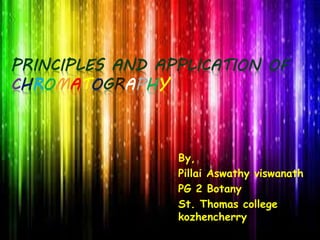
C.p aswathy viswanath
- 1. PRINCIPLES AND APPLICATION OF CHROMATOGRAPHY By, Pillai Aswathy viswanath PG 2 Botany St. Thomas college kozhencherry
- 2. INTRODUCTION The word chromatography means "color writing“ It is an important technique employed for the separation , isolation and identification of the components of a mixture Chromatography is a method used by scientists for separating organic and inorganic compounds. This method is particularly useful when the components in the mixture have almost the same physical and chemical properties
- 3. Some materials appear homogenous, but are actually a combination of substances. For example, green plants contain a mixture of different pigments. While studying the coloring materials in plant life, a Russian botanist invented chromatography in 1903. His name was M.S. Tswett.
- 4. He continued to work with chromatography in the first decade of the 20th century, primarily for the separation of plant pigments such as chlorophyll, carotenes, and xanthophylls. Since these components have different colors (green, orange, and yellow,respectively) they gave the technique its name.
- 5. PRINCIPLES In all chromatography there is a mobile phase and a stationary phase. The stationary phase is the phase that doesn't move and the mobile phase is the phase that does move. The mobile phase moves through the stationary phase picking up the compounds to be tested.
- 6. As the mobile phase continues to travel through the stationary phase it takes the compounds with it. At different points in the stationary phase the different components of the compound are going to be absorbed and are going to stop moving with the mobile phase.
- 7. This is how the results from the point at which the different components of the compound stop moving and separate from the other components. The interaction between the mobile phase and the stationary phase results in the separation of the compound from the mixture.
- 8. There are four main types of chromatography. These are:- Paper Chromatography. Thin-Layer Chromatography Gas Chromatography, Liquid Chromatography,
- 9. PAPER CHROMATOGRAPHY Paper chromatography is considered to be the simplest and most widely used Paper chromatography is the method in which the analysis of an unknown substance is mainly done by the flow of solvent on specially designed filter paper
- 10. Paper chromatography is a technique that involves placing a small dot or line of sample solution onto a strip of chromatography paper. The paper is placed in a jar containing a shallow layer of solvent and sealed. As the solvent rises through the paper, it meets the sample mixture, which starts to travel up the paper with the solvent.
- 11. Capillary action is used to pull the solvents up through the paper and separate the solutes. A strip of paper as the stationary phase.
- 12. APPLICATION Separating amino acids and anions, RNA fingerprinting, Separating and testing histamines, Antibiotics
- 13. THIN-LAYER CHROMATOGRAPHY Thin layer chromatography (TLC) is a widely employed laboratory technique and is similar to paper chromatography. However, instead of using a stationary phase of paper, it involves a stationary phase of a thin layer of adsorbent like silica gel, alumina, or cellulose . Compared to paper, it has the advantage of faster runs, better separations, and the choice between different adsorbents.
- 15. APPLICATION Thin-layer Chromatography uses an absorbent material on flat glass or plastic plates. This is a simple and rapid method to check the purity of an organic compound. It is used to detect pesticide or insecticide residues in food. Thin-layer chromatography is also used in forensics to analyze the dye composition of fibers.
- 16. HIGH PERFORMANCE LIQUID CHROMATOGRAPHY (HPLC ) Liquid chromatography is variously known as high pressure , high speed or high performance liquid chromatography Liquid chromatography is a separation technique in which the mobile phase is a liquid. Liquid chromatography can be carried out either in a column or a plane.
- 17. In HPLC the sample is forced by a liquid at high pressure (the mobile phase) through a column that is packed with a stationary phase composed of irregularly or spherically shaped particles. The interaction between the mobile and the stationary phase leads to the separation of the mixture.
- 18. Present day liquid chromatography that generally utilizes very small packing particles and a relatively high pressure is referred to as high performance liquid chromatography (HPLC).
- 19. The chromatographic techniques are slow & time consuming, hence the separation can be greatly improved by using high pressure in the range of 5000-10000 psi(pounds per square inch),hence this technique is also referred to as high pressure liquid chromatography.
- 20. APPLICATION It is used in the world to test water samples to look for pollution in lakes and rivers. It is used to analyze metal ions and organic compounds in solutions. Liquid chromatography uses liquids which may incorporate hydrophilic,insoluble molecules.
- 21. GAS CHROMATOGRAPHY One of the newest and most versatile technique for analyzing complex mixture Gas chromatography also sometimes known as Gas-Liquid chromatography It is a separation technique in which the mobile phase is a gas. Stationary phase is an inert solid material impregnated with a non-volatile liquid.
- 22. Here the mixture is separated in to constituents by a moving gas phase passing over a stationary adsorbent The separation of the mixture is based on the partition of the components between the mobile phase(gas) and stationary phase (liq.) hence the name Gas-liquid Chromatography.
- 23. It is the method of choice for the separation of volatile substances or the volatile derivatives of certain non- volatile substances. In gas chromatography helium is used to move a gaseous mixture through a column of absorbent material.
- 24. APPLICATION It is used in airports to detect bombs and is used is forensics in many different ways. It is used to analyze fibers on a persons body and also analyze blood found at a crime scene. Largely used for the chromatographic separation of aromatic isomers like xylenes,toluidines,cresols and dichlorobenzene
